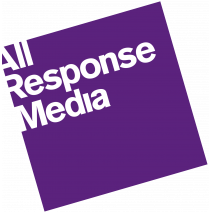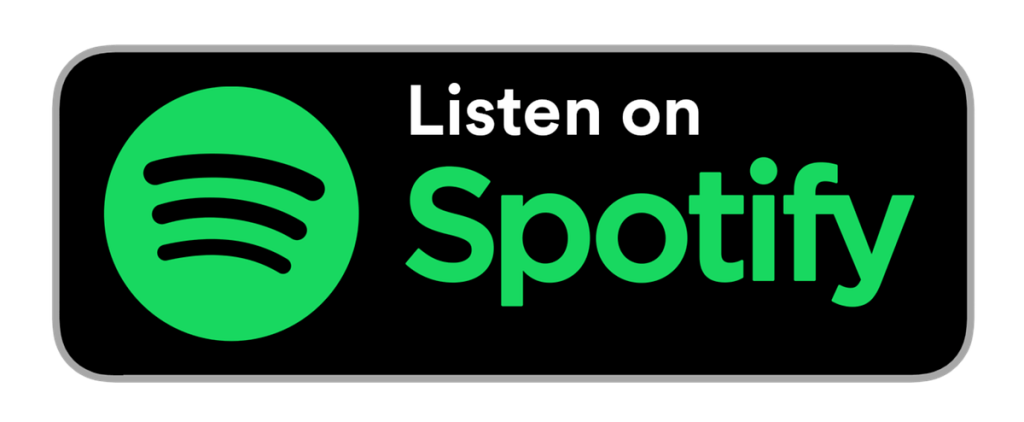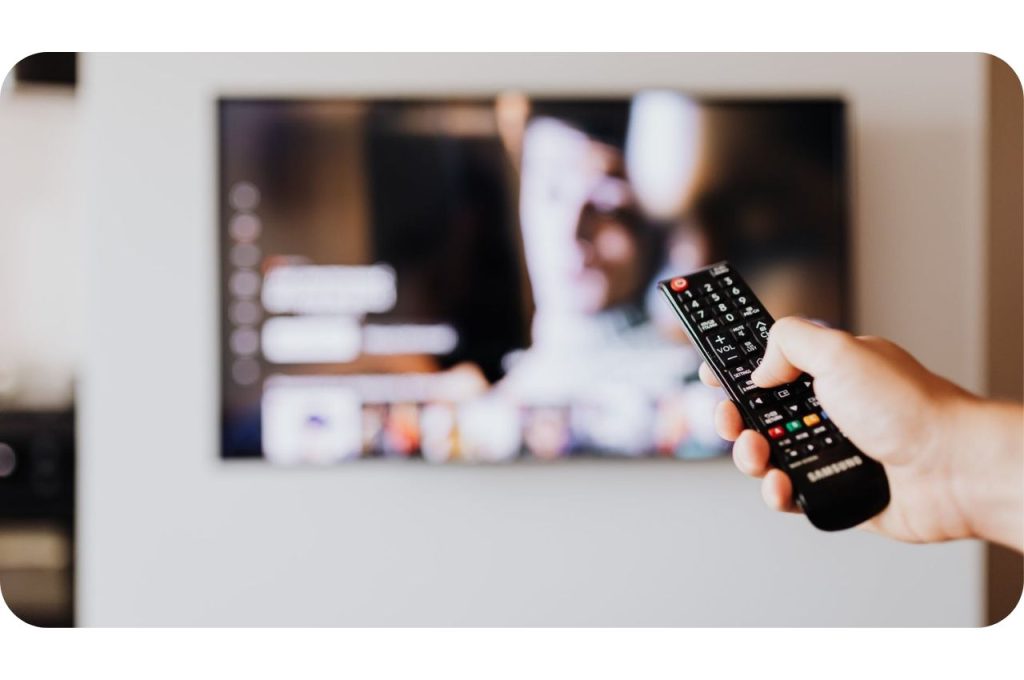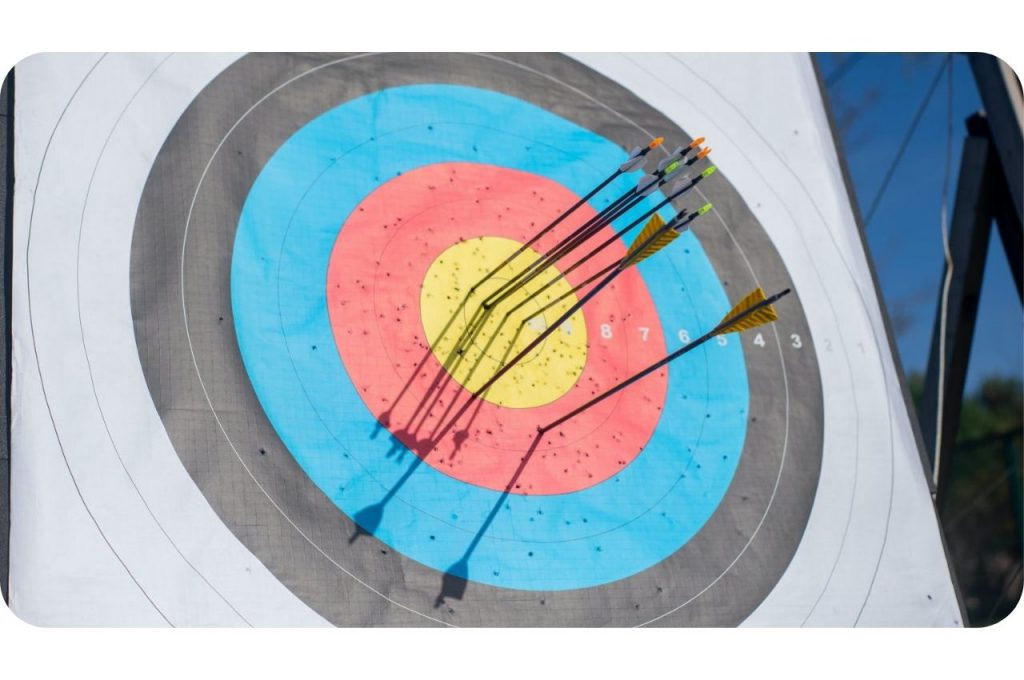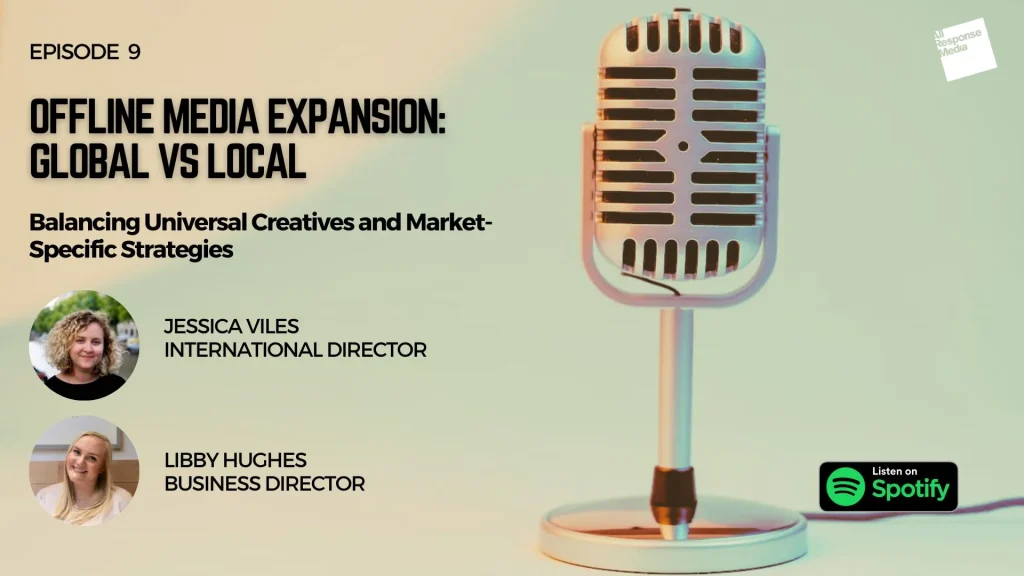
How can businesses adapt their tactics and creatives to fit local contexts, whilst ensuring campaigns resonate effectively across diverse markets?
In our latest episode, we delve into the delicate balance between global and local marketing strategies. From creative adaptation to offline expansion, we cover media buying challenges, CTV development, and practical tips for resonating with diverse audiences. Join us for all of the above as well as insights on performance vs. branding.
Watch or read the full episode below.
Global vs Local Strategy
In a previous podcast, we explored expanding into new markets from both digital and an offline perspective. Now, the focus is on localising a global strategy once a company is established in those markets.
Understanding Media Pricing
When discussing offline strategies, particularly with a TV focus, the way media is bought in different countries can significantly impact the speed, cost, and effectiveness of your campaigns. Media pricing varies widely across markets. For instance, in the Nordics, prices can exceed €10 per 1,000 impressions, whereas in Spain, Italy, or France, it might be as low as €1.02. These differences can greatly influence your strategy. After determining the audience size and market effectiveness, the next step is to evaluate media pricing to identify the most cost-effective launch locations.
Choosing the Right Media
Determining the most effective media in each market involves using planning tools and other information sources. We utilise Global Web Index (GWI), a quarterly global survey that provides insights into media consumption and time spent on each medium. This helps us understand market responses and audience behaviour. For example, places like Spain, France, a lot of the Southern European market, linear TV isn’t moving that much. But in the Nordics, connected TV is becoming more and more important. By using that tool we can understand both our reach but also our index. If you’re targeting a much younger ABC One audience, for example, TV might not be the answer, so in which case we’d look at things like podcasts or streaming, online streaming and music streaming.
Podcasts and Market Maturity
Podcasts are an interesting case as their maturity varies across markets. In the UK (where American content is prevalent), podcasts are quite popular. In Germany, however, costs can be higher, especially for host-read ads or partnerships. Platforms like Spotify are changing this dynamic by offering a single-entry cost. We use GWI to understand reach and index, and then overlay this with our market knowledge. For instance, France is typically very responsive, while Germany might take longer to yield positive returns. Nevertheless, despite the slower turnaround, with Germany you’ve got a huge population, which still makes it a strong market.
Blurring Lines Between Digital and Offline
The distinction between digital and offline media is becoming increasingly blurred. Again, GWI helps us decide whether to invest in offline or digital media, considering the pros and cons of each. Connected TV and digital audio are examples where traditional boundaries no longer apply. Different markets have varying responsiveness, which affects performance and branding campaigns. Understanding these nuances is crucial for effective strategy development.
Performance vs Branding Campaigns
Media buying strategies vary significantly across different markets due to the unique ways in which media is sold. For instance, in the Nordics or Benelux, media is often purchased as a package. This means that regardless of your preferences, you’ll likely find yourself on the major stations, achieving high reach. This necessitates a more blended strategy.
While we can’t split the media we’re buying, we can consider different creatives for different times of the day. In these markets, we’re also dealing with smaller universes. For example, being in the voice in Norway is considerably cheaper than in the UK or Germany. Interestingly, we find that these big brand spots work well for response too, serving a dual purpose.
In contrast, in Italy, media is sold per spot, allowing us to clearly define what might be a brand versus what might be performance. Stations like Sky in Italy offer low cost, high frequency, but relatively small audiences, making them great for performance. However, we’d always overlay this with a higher reach to ensure brand awareness.
Sky, with its 2-3 million subscriptions in Italy, offers a smaller but more affluent pool, which depending on your audience, you can balance it. In France, we find that the best combination is to allocate maybe 60% of your budget on a big station like TF1 or M6. Because of the way media is bought in France, we can buy spots that are most effective for our audience. We can look at index, day of week, programming, and so on. We also always have a level of what they call the digital channels, smaller stations that allow us to build frequency and mop up the performance.
Germany has a unique way of buying brand versus performance. The performance element comes from years ago when TV stations would sell leftover inventory at a lower price to companies needing to get rid of extra stock. These adverts had to have a call to action, be very direct response, and include a website or phone number.
While the lines between what is a performance ad and a brand ad have blurred over time, the model in Germany has remained the same. To access DRTV pricing, your ad must have a URL on page the whole time, a voiceover, and a call to action. The pricing difference can be a 50% to 70% discount off rate card, which can be substantial.
Leveraging Digital Insights
A common practice in digital media is to test different creatives across various platforms to determine what resonates with the audience. One of the advantages of digital media is the ability to quickly swap out creatives based on their performance, allowing the accumulation of learnings over time. This process is typically slower with linear TV.
The digital-first approach also provides an excellent means of testing potential new markets. By assessing the responsiveness of a market and the effectiveness of different creatives, brands can gain valuable insights before fully committing. This approach is often used as a preliminary step to gauge market viability.
There’s no need to jump directly into connected TV. Platforms like YouTube offer a lower barrier to entry and access to their connected TV inventory. Alternatively, brands can turn to platforms like Meta, which are universally recognised in the digital landscape.
The digital landscape, particularly among the major players, is more aligned across all markets compared to the offline world. These platforms provide quick learnings, helping brands identify what resonates with their audience and incorporate these insights into their overarching strategy.
Payment Methods and User Behaviour
Testing your website and user journeys can be particularly insightful, especially when it comes to understanding how different payment methods resonate in various markets. For instance, Germany had a strong invoice culture until recently. Customers would order a product and pay the invoice upon its arrival. The transition from this to immediate online payment took some time.
Now, with the advent of services like Klarna, the process has become more streamlined. However, we’ve had clients who launched in Germany and were puzzled by customers adding items to their carts and then abandoning them. This highlights the importance of digital testing. It allows us to determine whether people are willing to pay with a credit card, whether we need to invest in Klarna, or whether we need to add another payment option to our site.
Buying Methods Across Europe
There are three primary methods for buying TV and radio media.
Firstly, we have the cost per spot method, prevalent in countries like Italy, France, Spain, and Germany. This method allows you to know the cost of the spot before purchasing, independent of ratings. It offers the flexibility to cherry-pick spots that fit your audience and optimisations. However, the downside is the potential to overpay. For instance, in Italy, we might pay a cost per spot on platforms like Sky or Discovery, where ratings aren’t always high. Consequently, the Cost Per Mille (CPM) can fluctuate significantly from week to week, depending on audience ratings. This fluctuation can impact performance, making it crucial to monitor closely.
The second method is buying based on the cost per Gross Rating Point (GRP) or Television Rating (TVR). In most of Europe, it’s referred to as a GRP, while in the Nordics, it’s known as a Target Audience Rating Point (TARP). This method involves paying a cost per 1% of the universe you’re buying against. The advantage is that you generally get what you want, hitting your GRP and reach targets. However, it requires close management of airtime, especially when ratings drop, such as during the summer or when a sporting event underperforms.
The third method is the cost per 1,000 or CPM, which is the metric used in the UK and some Nordic markets.
One advantage of European buying over the UK is the absence of reccy positions. You typically get what you pay for, ensuring that your media gets delivered when you want it, especially during important periods (like the build-up to Christmas). If they don’t deliver, they don’t charge you for it, eliminating the need for constant negotiations around positions. This makes media management easier and improves media performance.
Adapting Global Creatives Locally
The first step in adapting global creatives, typically received in English, is translation. However, we prefer to go beyond mere translation and engage in transcreation. This process ensures that the content resonates with different markets, as not everything translates perfectly.
For instance, we’ve noticed in our work with European markets that Germans tend to be more interested in the technology behind a product, Italians on aesthetics, and the French respond better to emotional appeals. We also consider other factors that resonate in certain markets. For example, Southern European markets like Spain respond well to discounts, a strategy that doesn’t work as well in some Northern markets. When working with American brands, we try to make sure their assets don’t feel too American, as they may not resonate in markets like Germany and France, where a more local feel is preferred.
Regarding language, technically, you don’t have to translate for digital platforms. However, in markets like France and Germany, running in the local language is essential. If you only have an English language creative, you can target users who have set their browser or social media platforms to English. However, this significantly reduces your target pool.
In markets like France, legal requirements mandate translation. In others like Germany, while there’s no approval board, we recommend translating at least the voiceover or call to action for better response. In Southern Europe, translation is crucial due to the large population segments that don’t speak English.
Finally, we recommend that your website language matches your ad copy language. If your website is only in English, it’s probably better to run with English language ad copy to provide a consistent user journey across all touchpoints.
Measurement Techniques in Media
When it comes to measurement, TV attribution data has been a standard. However, interesting developments are emerging in radio measurement. For instance, in the Netherlands, the measurement technique has transitioned from infrequent surveys to an active listening app. This shift has significantly changed our understanding of radio usage.
Previously, surveys asked people to recall what they’ve listened to, often leading to skewed results. The listening app, on the other hand, actively tracks when people are tuning into the radio. This has revealed that more people are listening than initially thought, leading many stations to increase their rates. It has also shown that more people are listening throughout the day, not just during drive time. This insight allows for more leverage in negotiating rates for drive time slots. Alongside that, this new approach has meant much more specific targeting. We’re investing in this data set to understand radio in the same way we do TV. While the response isn’t as immediate with radio due to listeners often being engaged in other activities, understanding this journey can provide valuable insights. By examining the response curve and integrating it with daily econometrics, we can gain a better understanding of the impact.
Seasonality in Digital Campaigns
Seasonality varies significantly across markets. In the UK and Ireland, Black Friday is a major retail peak, heavily influenced by American culture. However, this isn’t as pronounced in smaller European markets. Tools like Google Trends can help identify seasonality peaks by analysing search trends and consumer behaviour. For example, in France, sales periods are strictly defined, with major sales happening in January and June/July.
The Connected TV Journey
Many brands begin their connected TV (CTV) journey with YouTube. It’s an easy expansion if you’re already running YouTube campaigns across mobile, desktop, and tablet. However, it’s crucial to ensure your creative doesn’t include a call to action like ‘Click here’, which isn’t possible from a CTV perspective. Assuming the creative is suitable, YouTube is a straightforward first step into the CTV world, as its presence is growing across all markets, with the proportion of people watching YouTube on CTV increasing year on year. Beyond YouTube, newer players in the CTV advertising market include Amazon Prime, Disney Plus, and Netflix. These platforms are either already in all markets or rapidly expanding.
Netflix currently has a slightly higher cost to entry, with high CPMs, whereas Amazon and Disney Plus have lower barriers to entry. These platforms are consistent across all markets, making it relatively easy to expand programmatically through any Demand Side Platforms (DSPs) that are taking them on.
Each market also has its own local players. For example, in the UK, there are platforms like Channel 4 OnDemand and ITVX. In Europe, providers like RTL and IP Connect have a footprint in France, the Netherlands, Belgium, and Germany. In Germany, there’s RTL and Join, the ProSieben product, which have good reach. They also have a product called Zatu, live in the DAK region, which is essentially a CTV product that people buy into for advertising.
These platforms are growing, with products like Join now offering a creator’s network that runs through their YouTube channels. This is particularly useful for targeting younger audiences, as ads run amongst influencers, providing strong affinity quality content.
The balance between reach and cost is crucial. While platforms like Prime and Disney have higher CPMs, they offer greater reach, but ideally, a blend of the two would be used. Amazon Prime, although a new player in the market, offers sophisticated targeting. The richness of Amazon’s data, especially if you sell on Amazon, opens up a host of targeting possibilities, including competitor-conquesting. This level of specificity around targeting is powerful and not something other platforms like Google and Meta can match.
Seasonality in Offline Media
In markets like the UK and Ireland, and to a lesser extent across the rest of Europe, Christmas and Black Friday are significant retail peaks. Particularly for e-commerce or retail brands, Black Friday often marks the biggest week of the year. However, this trend doesn’t hold as strongly in smaller markets, where the lead-up to Christmas is generally more significant.
Understanding your market’s seasonality is crucial. One of the easiest ways to do this is through tools like Google Trends. By inputting your brand name or a generic search term related to your brand offering, you can observe when spikes occur, revealing different peak times throughout the year.
In France, for example, there are very defined sales periods. If you want to hold a sale, it needs to be at the start of the year, around January, or in the summer, around June or July. Outside of these periods, communication about sales must be more offer-led.
In Southern markets, there’s generally a lull in search demand and market competition during the summer. Advertising spend, CPMs, or CPCs, depending on your media channel, will generally dip across the summer due to fewer players in the market. These rates then gradually increase towards the end of the year.
Navigating Media Costs
Media costs and the availability of media owners vary across different markets and months. For instance, in the Nordics during May and June, media owners are often unavailable, typically responding with out-of-office messages indicating they’re at their cabins. Therefore, if you’re planning media during these months, it’s advisable to book for July, August, or even as early as March.
In Italy, Germany, and France, most people (including media owners), go on holiday in August. Many stations shut down during this period, making it challenging to get much done in terms of optimisations and rate planning. However, these periods can be beneficial due to their lower costs. In Italy, for example, you could be looking at paying only 40% of the usual rate.
These periods can be worth testing, especially if your product isn’t highly seasonal or if your target audience is older. In Italy, we find that older people are often still at home watching TV, even if they’re not in their usual residence. They might be in their lake house or holiday home, but they’re still watching TV, making these periods effective for advertising.
With the rise of Amazon, the Black Friday effect is now seen in virtually every country. This period sees high visits and sales, especially in e-commerce. However, media is expensive during these periods, and everyone wants to be on air. In markets where you have a cost per Gross Rating Point (GRP), there’s a high chance you won’t get delivered. You may end up paying more as many countries apply a market index, increasing your cost per GRP. It’s worth balancing whether it’s worth being on air during these periods unless you have a great offer to promote.
Lastly, the end of December and the general Christmas period is another time when viewing figures increase. This period can be effective for testing, especially for charities or e-commerce sales. In some markets, like Italy, the first week of January is still very cheap and considered part of the Christmas period, making it a great time to advertise. Additionally, the 6th of January is quite significant in certain markets, sometimes even more so than Christmas. Understanding these local nuances is crucial to ensure you’re phasing your media correctly.
Expanding into New Markets
The first step in expanding your business to a new market is to determine if your business can operate in that market. For instance, if you’re launching a credit card, starting with the Netherlands might not be the best choice due to the cultural preference for other payment methods. Tools like GWI can help you understand and scale up those markets.
Next, consider media costs. Identify where you can get the best return and which market will be the most cost-effective. Also, consider the ease of entering the market. If there are numerous approval boards to navigate, which could take weeks or even a month, it could slow down the process. Markets like Italy and Germany, for example, have fewer approval requirements for most industries, making them easier to enter. Also, consider the market size and how much you’re willing to spend. For example, in the Netherlands, a budget of about €200,000 can achieve 70% reach, whereas the same budget in Germany might only achieve 20% reach. It’s crucial to scale up your objectives and investment accordingly.
Finally, consider how much you can test with digital assets. If you’re already running Pay-Per-Click (PPC) or Meta campaigns in those markets, identify which ones work well and yield the best response. These insights can then be used to inform your market expansion strategy.
Conclusion
Balancing global tools with local nuances is key to successful media campaigns. By understanding seasonality, media costs, and market-specific challenges, advertisers can create effective strategies that resonate with diverse audiences. Whether using global platforms for quick launches or leveraging local insights for targeted campaigns, the goal is to remain flexible and responsive to market dynamics.
Get in touch with our digital team today
Find out how we can combine digital, TV and data science expertise to get the most out of your advertising budget.
FEATURED READS
See our services

Digital
Make your digital presence profitable. Supercharge your online paid media campaigns using our audience-first approach.

Offline
Be where your audience wants you to be. All Response Media provide full planning, delivery and optimisation to your offline campaigns.

Data & Systems
Our ARMalytics platform provides services tailored to your audience’s needs. We provide full performance attribution and transparency.
